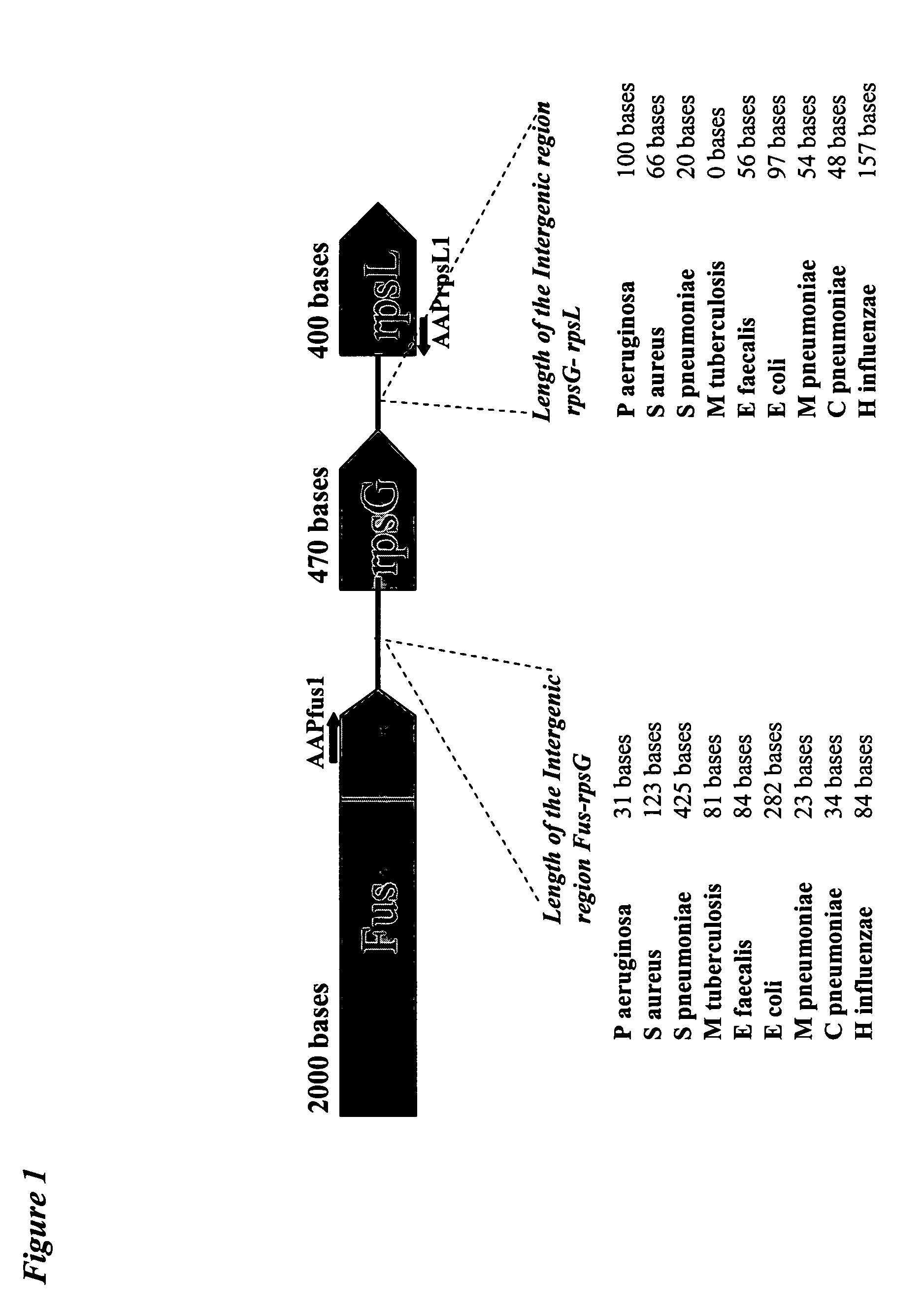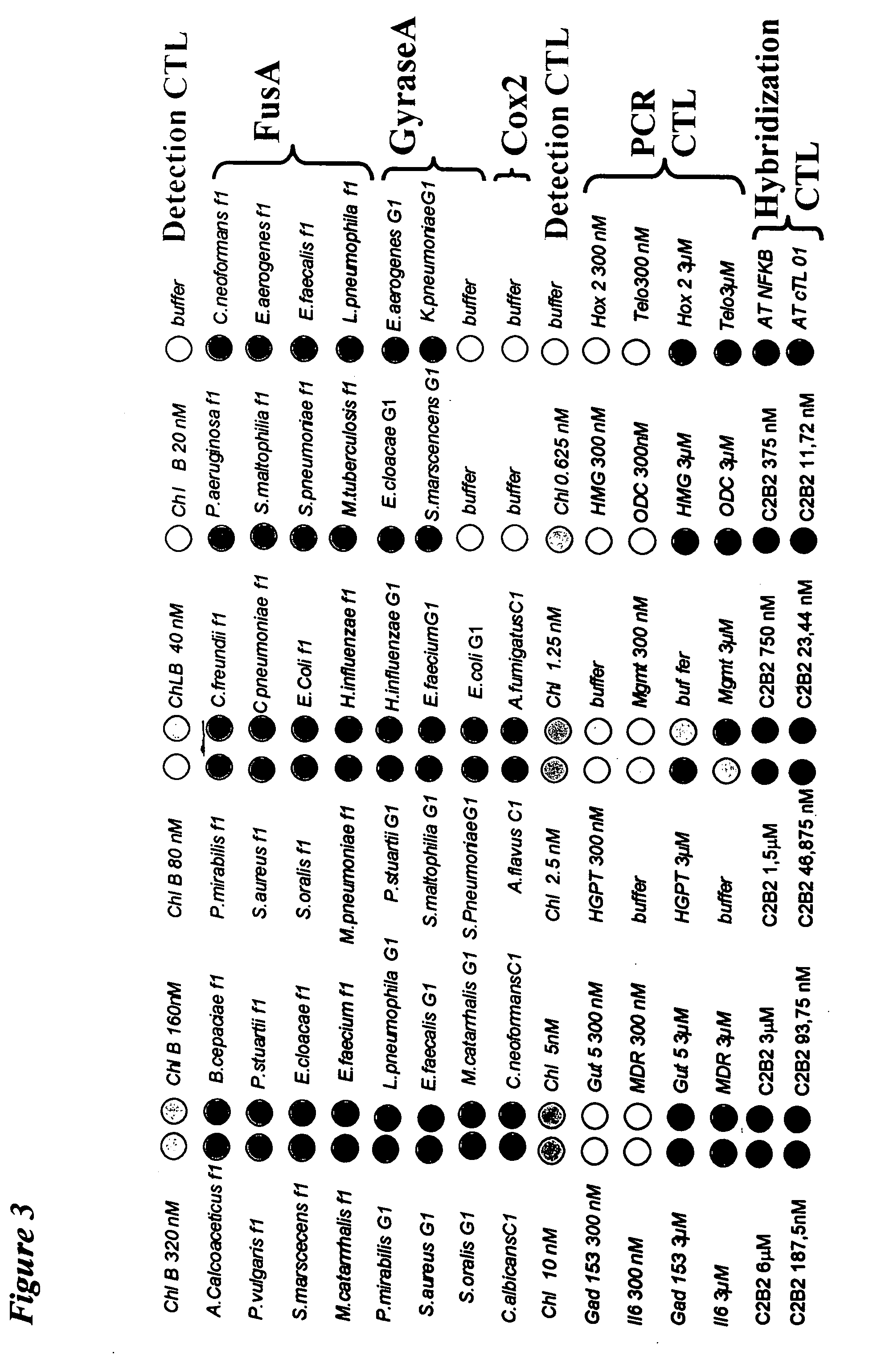Method and kit for the detection and/or quantification of homologous nucleotide sequences on arrays
- Summary
- Abstract
- Description
- Claims
- Application Information
AI Technical Summary
Benefits of technology
Problems solved by technology
Method used
Image
Examples
example 1
Detection of 18 Homologous Fus-rpsG-rpsL Sequences on Array Bearing Specific Capture Nucleotide Sequences Selected in Two Intergenic Regions (FIG. 1)
Bacterial Strains
[0092] Reference strains of E. aerogenes ATCC 13048, E. coli ATCC 10536, S. marcescens ATCC 13880, P. stuartii ATCC 25826, H. influenzae ATCC 19418, P. vulgaris ATCC 21100, C. freundii ATCC 8090, E. cloacae ATCC 13047, M. catarrhalis ATCC 23246, M. tuberculosis ATCC 25584, M. pneumoniae ATCC 15531, L. pneumophila ATCC 35096, A. calcoaceticus ATCC 53701, S. aureus ATCC 25923, E. faecium ATCC 35667, E. faecalis ATCC 29212, S. pneumoniae ATCC 33400 and S. oralis ATCC 35027 were obtained from the Deutsche Sammlung von Mikroorganismen und Zellkulturen GmbH (DSMZ, Germany).
DNA Purification
[0093] Bacterial stains were grown from single colonies in LB medium (10 g of peptone, 5 g of yeast extract and 5 g of NaCl / 1) overnight at 37° C. in aerobic conditions. An aliquot (0.1 ml) of an overnight culture was pelleted by centr...
example 2
Detection of 24 Homologous Fus-rps-G-rpsL Sequences on Array Bearing Specific Capture Nucleotide Sequences Selected in Two Intergenic Regions (FIG. 2)
[0104] The experiment was conducted as described in example 1. The additional reference ATCC strains are the following: P. aeruginosa ATCC 10145, C. neoformans ATCC 11239, C. pneumoniae ATCC VR-1310, P. mirabilis ATCC 25933, B. cepacia ATCC 10856 and S. maltophilia ATCC 13637 were obtained from the Deutsche Sammlung von Mikroorganismen und Zellkulturen GmbH (DSMZ, Germany).
[0105] The inclusion in the assay of additional consensus primers allowed to increase the number of bacteria species identified and also the identification of one fungi (C. neoformans). Part of the Translation elongation factor G (Fus-A) and of the 30S ribosomal protein S7 (rpsG) and of the 30S ribosomal protein S12 (rpsL) corresponding to the different bacteria and fungi species were amplified by PCR using the following primers:
TABLE 7Sequence of the primers for...
example 3
Detection of 16 Homologous Gyrase Sequences on Array Bearing Specific Capture Nucleotide Sequences Selected in the Gyrase Coding Region
[0110] The experiment was conducted as described in example 1. The additional reference ATCC strains is K. pneumoniae ATCC 10031.
[0111] Part of the gyrase A (GYR) gene corresponding to the different Gram− and Gram+ bacteria species were amplified by PCR using the following primers:
gyr15′ GCNGCDGCRATGCGTTATAC 3′(SEQ ID NO: 139)gyr55′ CGCAGMTCSAGRATCGCCTG 3′(SEQ ID NO: 140)gyr35′ GAACCHYKACCTGTTTCATA 3′(SEQ ID NO: 141)
N = A, G, T, C
D = G, A, T
R = A, G
M = A, C
S = G, C
H = A, T, C
Y = C, T
K = G, T
[0112]
TABLE 9Sequence of the primers for the amplification of Gram− (A) and Gram+ (B)bacteria species in the gyrase A markers and number of mismatch betweenthe species sequence and the primer.sequences sense 5′ −> 3′Mismatchsequences antisense 5′ −> 3′MismatchA.Gram−SpeciesE. aerogenesGCCGCGGCAATGCGTTATAC(SEQ ID3CGCAGATCGAGGTCGCCTA(SEQ ID2NO: 142)NO: 1...
PUM
| Property | Measurement | Unit |
|---|---|---|
| Fraction | aaaaa | aaaaa |
| Current | aaaaa | aaaaa |
| Current | aaaaa | aaaaa |
Abstract
Description
Claims
Application Information
 Login to View More
Login to View More - R&D
- Intellectual Property
- Life Sciences
- Materials
- Tech Scout
- Unparalleled Data Quality
- Higher Quality Content
- 60% Fewer Hallucinations
Browse by: Latest US Patents, China's latest patents, Technical Efficacy Thesaurus, Application Domain, Technology Topic, Popular Technical Reports.
© 2025 PatSnap. All rights reserved.Legal|Privacy policy|Modern Slavery Act Transparency Statement|Sitemap|About US| Contact US: help@patsnap.com



